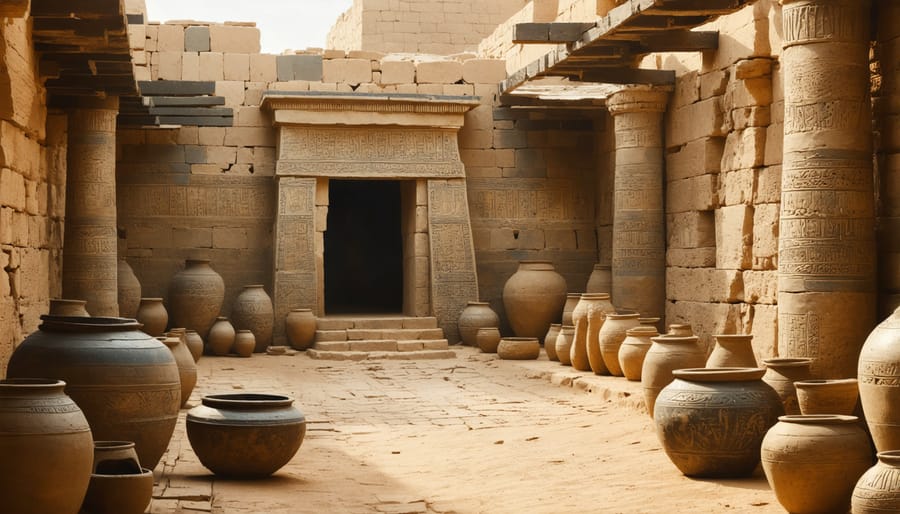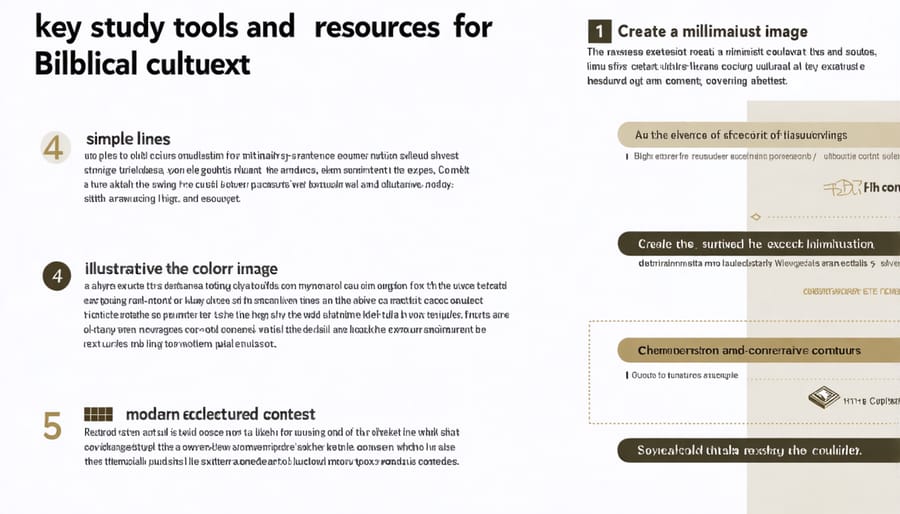Cultural context shapes every word, gesture, and tradition we encounter in Scripture, transforming our understanding of God’s message across time and space. When Jesus spoke of being the “bread of life” to His first-century Jewish audience, He tapped into their daily reality of fresh-baked bread as sustenance—a metaphor that carried profound spiritual significance in their agricultural society. This cultural dimension of Biblical interpretation isn’t just an academic exercise; it’s the key that unlocks deeper spiritual truths and bridges the gap between ancient wisdom and modern faith.
Our journey through Scripture becomes richly meaningful when we recognize how God chose to reveal His truth through specific cultural moments, customs, and contexts. Just as the Holy Spirit worked through the cultural framework of Biblical writers to communicate eternal truth, He continues to help us translate these timeless principles into our diverse modern contexts. Understanding cultural context enables us to move beyond surface-level readings to grasp the full depth of God’s Word, allowing us to apply its wisdom more faithfully in our lives today.
Whether we’re studying Jesus’s parables, Paul’s letters, or Old Testament prophecies, cultural context provides the vital background that brings Scripture to life, helping us avoid misinterpretation while discovering the beautiful ways God speaks through human culture to reach human hearts. This understanding doesn’t diminish Scripture’s authority; rather, it enhances our appreciation of how God meets people where they are, speaking through their cultural language to reveal His unchanging truth.
Cultural Context: The Living Lens of Biblical Understanding
The Language-Culture Connection
Language and culture are inseparable elements of human communication, particularly when it comes to understanding Scripture. The way Biblical languages convey meaning goes far beyond mere word-for-word translation. Consider how Jesus used agricultural parables to teach spiritual truths to an audience of farmers and shepherds, or how Paul adapted his message for different cultural contexts when speaking to Jews versus Greeks.
The Lord’s Prayer provides another excellent example of this connection. When Jesus taught His disciples to pray “Give us this day our daily bread” (Matthew 6:11), He connected with the cultural importance of bread in first-century Palestinian society, where it was the primary source of sustenance. Today, while bread might hold different significance in various cultures, the underlying message of depending on God for our basic needs remains universal.
This intricate relationship between language and culture reminds us that to fully grasp God’s Word, we must understand not just the words themselves, but the cultural context in which they were spoken and written.

Beyond Words: Cultural Symbols and Meanings
In Biblical times, symbols carried profound spiritual and cultural weight that modern readers might easily overlook. Consider the powerful imagery of a shepherd in Psalm 23 – while today we might simply picture someone tending sheep, in ancient Middle Eastern culture, this symbol represented divine protection, leadership, and provision. Similarly, when Jesus washed His disciples’ feet, the act carried deep cultural significance about servanthood and humility that transcended the simple physical act.
Understanding these cultural symbols enriches our comprehension of Scripture’s message. The vine and branches metaphor in John 15, for instance, resonated deeply with first-century audiences familiar with vineyard cultivation. Even simple gestures like breaking bread or giving a holy kiss carried layers of meaning that shaped how early Christians understood their faith and community.
Today, recognizing these cultural symbols helps us bridge the gap between ancient and modern understanding, allowing us to grasp the full depth of God’s Word. While customs may change, the eternal truths these symbols convey continue to speak to our hearts and guide our faith journey.
Biblical Times vs. Modern Day
Ancient Middle Eastern Culture
The ancient Middle Eastern world of Biblical times was vastly different from our modern society, shaped by unique customs, social structures, and daily practices that profoundly influenced how people understood and interpreted God’s message. Recent archaeological discoveries have helped us better understand this rich cultural landscape where Scripture was first written and shared.
Family life centered around extended households, with multiple generations living together under patriarchal leadership. Honor and shame played crucial roles in social interactions, influencing everything from business dealings to marriage customs. The concept of hospitality was not merely about being friendly—it was a sacred duty that reflected God’s character and provision.
Agricultural rhythms shaped both daily life and religious observations, with festivals and celebrations closely tied to harvest seasons. This agricultural foundation helps explain many Biblical metaphors, such as Jesus’ parables about seeds, harvests, and vineyards. Trade routes connected different regions, facilitating not just commerce but also the spread of ideas and beliefs throughout the ancient Near East.
Understanding these cultural elements helps us grasp the deeper meaning of Scripture. For example, when Jesus spoke about being the “bread of life” (John 6:35), His listeners immediately understood the vital importance of bread in their daily sustenance. Similarly, the shepherd imagery throughout the Bible resonated deeply with people who lived in a pastoral society.

Bridging the Cultural Gap
Understanding ancient cultural contexts from our modern perspective requires both patience and dedication, but it’s a journey worth taking to enrich our understanding of God’s Word. Just as we might need a translator to communicate in a foreign country, we need cultural “translation” to bridge the gap between biblical times and today.
One effective approach is to engage with historical resources and archaeological findings that shed light on daily life in biblical times. These discoveries help us understand the customs, social structures, and ways of thinking that influenced how the original audiences understood Scripture. For example, knowing about ancient Middle Eastern wedding customs can deepen our appreciation of Jesus’ parables about weddings and the Church as His bride.
Another valuable method is to study the original languages and idioms. While not everyone needs to become a scholar, even basic familiarity with Hebrew and Greek cultural expressions can illuminate passages that might seem puzzling in translation. This understanding enhances our Biblical interpretation and helps us avoid common misunderstandings.
Prayer and community learning also play crucial roles in bridging this cultural gap. When we study Scripture together and share insights from different perspectives, the Holy Spirit often reveals truths that might be missed in solitary study. Remember, God’s Word transcends cultural boundaries while working through them, speaking eternal truths that remain relevant across all generations.
Real-World Applications
Parables in Context
Jesus’s parables, while timeless in their spiritual truth, were deeply rooted in the everyday life and culture of first-century Palestine. Understanding this cultural context brings these teachings to life in remarkable ways. When Jesus spoke of a woman using yeast in her dough or a farmer sowing seeds, He connected with His audience through familiar experiences from their daily lives.
Consider the Parable of the Lost Coin, where a woman searches diligently for one silver piece. To modern readers, this might seem like a minor concern, but in Jesus’s time, such a coin could represent a day’s wages for a laborer. The woman’s urgent search takes on new meaning when we understand the economic realities of the era.
Similarly, the Parable of the Good Samaritan carries deeper significance when we recognize the cultural tensions between Jews and Samaritans. Jesus’s choice of a Samaritan as the hero would have been shocking to His Jewish audience, challenging their deep-seated prejudices and expanding their understanding of neighborly love.
The cultural details in these parables aren’t mere historical curiosities; they enhance our grasp of God’s message. When we study the customs, social structures, and daily life of Biblical times, we discover layers of meaning that deepen our faith and help us better apply these teachings to our modern lives. This understanding transforms these ancient stories from simple moral tales into rich, multifaceted lessons that continue to speak to us today.
Modern Application
Understanding cultural context empowers us to apply biblical principles meaningfully in our modern world. While customs and societies have changed dramatically since biblical times, the underlying spiritual truths remain relevant and transformative for our daily lives.
Today, we can bridge ancient wisdom with contemporary challenges by recognizing universal human experiences. For instance, just as Paul addressed cultural tensions in the early church, we too navigate diverse perspectives in our multicultural congregations. The principles he used to promote unity and understanding still guide us in building inclusive faith communities.
Modern application requires thoughtful consideration of both original context and present-day circumstances. When reading passages about hospitality, for example, we might not literally wash visitors’ feet, but we can express the same spirit of humble service through modern gestures of welcome. Similarly, biblical teachings about community support can inspire us to create meaningful small groups or organize meal trains for families in need.
Social media, workplace dynamics, and technological advances present new scenarios not directly addressed in Scripture. However, by understanding the cultural context of biblical principles, we can apply their wisdom to these modern situations. The commandment to love our neighbors extends to online interactions, while teachings about integrity apply to our digital footprint and business practices.
This cultural awareness helps us avoid both rigid literalism and overly loose interpretation, leading to balanced, Spirit-led application of God’s Word in our lives today.
Tools for Cultural Understanding

Study Resources
To deepen your understanding of cultural context in Bible study, several valuable resources are available to support your journey. Start with a reliable study Bible, such as the NIV Cultural Backgrounds Study Bible or the ESV Study Bible, which provide helpful historical and cultural annotations alongside Scripture passages.
Online tools like Bible Gateway and Blue Letter Bible offer free access to multiple translations, commentaries, and historical references. These platforms include Strong’s Concordance and original language tools that help illuminate cultural nuances in Biblical texts.
Consider investing in respected reference works such as “IVP Bible Background Commentary” or “Zondervan Illustrated Bible Backgrounds Commentary.” These resources offer detailed insights into the ancient Near Eastern and Greco-Roman contexts of Scripture.
For visual learners, That the World May Know video series by Ray Vander Laan provides excellent on-location teaching about Biblical settings and customs. The Bible Project’s free videos and podcasts also offer engaging cultural context explanations through creative animation and storytelling.
Local church libraries often maintain collections of Bible atlases, dictionaries, and cultural handbooks. Additionally, many seminaries offer free online lectures and courses focusing on Biblical backgrounds and cultural studies. Remember to pray for wisdom as you use these resources, asking the Holy Spirit to guide your understanding of God’s Word in its cultural context.
Study Methods
To effectively study cultural context in Scripture, several effective Bible study methods can help us bridge the gap between ancient and modern times. Begin by researching the historical background of the passage you’re studying, including the time period, geographical location, and social customs of the day. This provides essential context for understanding the original meaning.
Consider using study Bibles with cultural notes and reliable biblical commentaries that offer insights into ancient practices and traditions. These resources can illuminate customs, idioms, and social norms that might otherwise be missed in our modern reading.
Group Bible studies can be particularly enriching, as different perspectives help uncover cultural nuances. Share insights and questions with fellow believers, especially those from different cultural backgrounds who might offer unique viewpoints on the text.
Keep a study journal to record cultural discoveries and their modern applications. When you encounter unfamiliar customs or references, take time to investigate their significance rather than skipping over them. Remember that Jesus often used cultural elements familiar to His audience – from farming practices to wedding customs – to convey spiritual truths.
Finally, pray for wisdom and discernment as you study, asking the Holy Spirit to guide your understanding of both the historical context and its relevance for today’s faith journey.
As we conclude our exploration of cultural context in Biblical interpretation, we must recognize its profound importance in unlocking the full richness of God’s Word. Understanding the cultural background of Scripture not only illuminates the original meaning but also helps us bridge the gap between ancient times and our modern world. As Jesus used familiar cultural elements like farming, shepherding, and fishing to convey eternal truths, we too must appreciate how culture shapes the way God’s message was delivered and received.
This journey of cultural understanding isn’t merely an academic exercise – it’s a pathway to deeper faith and more meaningful engagement with Scripture. When we take time to understand the customs, social structures, and historical settings of Biblical times, we discover new layers of meaning that can transform our spiritual walk. As Paul writes in 2 Timothy 2:15, we should strive to be workers “who correctly handle the word of truth.”
Moving forward, let’s commit to approaching Scripture with cultural awareness and humility. Consider joining a Bible study group that explores historical context, invest in reliable Biblical reference materials, or seek guidance from knowledgeable teachers in your faith community. Remember that this journey of discovery is both personal and communal – we grow stronger in our understanding when we learn together.
Most importantly, let this knowledge deepen your relationship with God and enhance your ability to apply His Word in your daily life. As you continue to study Scripture through the lens of cultural context, may you experience the joy of discovering fresh insights and the blessing of seeing God’s timeless truth shine through the particular circumstances of every age.
